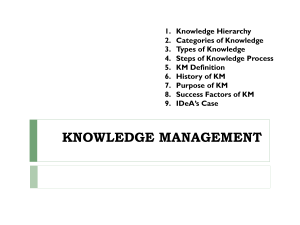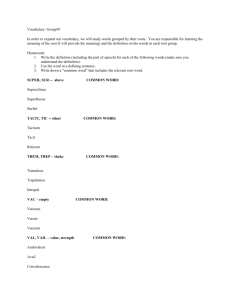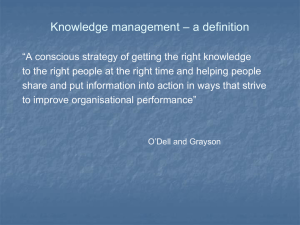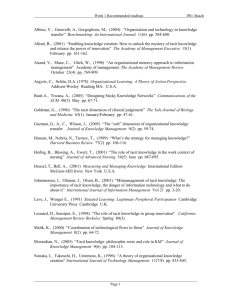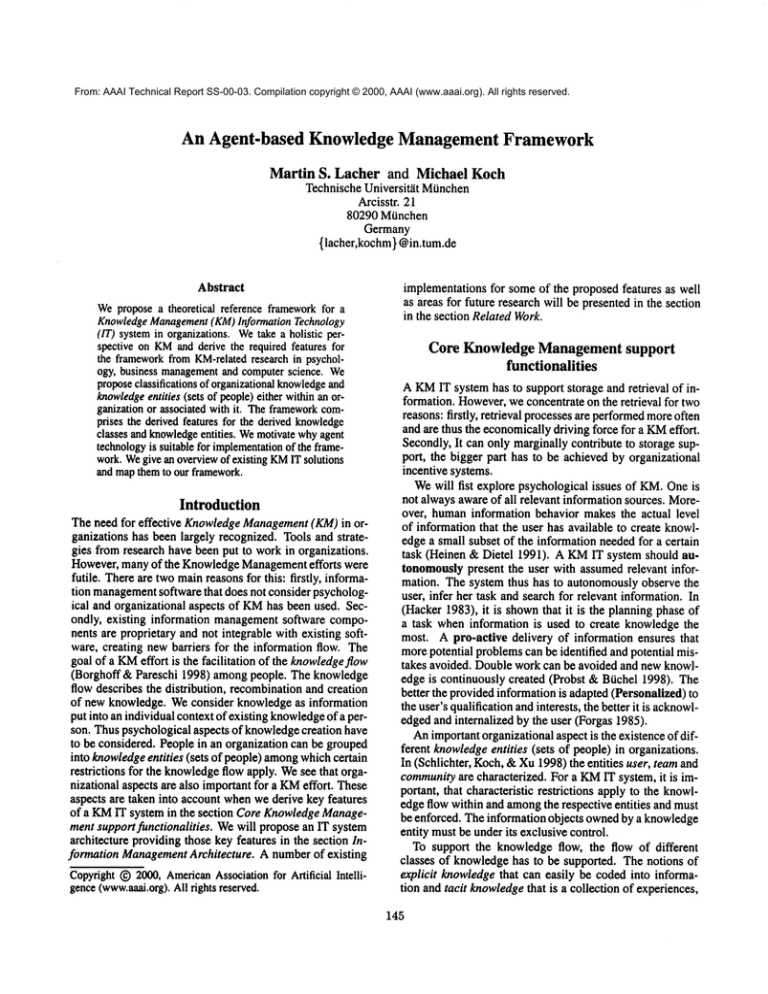
From: AAAI Technical Report SS-00-03. Compilation copyright © 2000, AAAI (www.aaai.org). All rights reserved.
An Agent-based Knowledge Management Framework
Martin
S. Lacher and Michael Koch
Technische Universit~t Mtinchen
Arcisstr. 21
80290 Mtinchen
Germany
{lacher,kochm} @in.tum.de
Abstract
Wepropose a theoretical reference frameworkfor a
Knowledge
Management
(KM)Information Technology
(IT) systemin organizations.Wetake a holistic perspective on KMand derive the required features for
the frameworkfrom KM-relatedresearch in psychology, business management
and computerscience. We
proposeclassifications of organizationalknowledge
and
knowledge
entities (sets of people)either withinan organization or associated with it. Theframework
comprises the derivedfeatures for the derivedknowledge
classes and knowledge
entities. Wemotivatewhyagent
technology
is suitable for implementation
of the framework.Wegive an overviewof existing KM
IT solutions
and mapthemto our framework.
Introduction
The need for effective KnowledgeManagement(KM) in organizations has been largely recognized. Tools and strategies from research have been put to work in organizations.
However, manyof the KnowledgeManagementefforts were
futile. Thereare two mainreasons for this: firstly, information management
software that does not consider psychological and organizational aspects of KMhas been used. Secondly, existing information managementsoftware components are proprietary and not integrabl¢ with existing software, creating new barriers for the information flow. The
goal of a KMeffort is the facilitation of the knowledgeflow
(Borghoff & Pareschi 1998) amongpeople. The knowledge
flow describes the distribution, recombinationand creation
of new knowledge. Weconsider knowledgeas information
put into an individual context of existing knowledge
of a person. Thus psychological aspects of knowledgecreation have
to be considered. People in an organization can be grouped
into knowledgeentities (sets of people) amongwhichcertain
restrictions for the knowledgeflow apply. Wesee that organizational aspects are also importantfor a KMeffort. These
aspects are taken into account whenwe derive key features
of a KMIT system in the section Core KnowledgeManagement support functionalities. Wewill propose an IT system
architecture providingthose key features in the section Information ManagementArchitecture. A number of existing
Copyright(~1 2000,American
Associationfor Artificial Intelligence(www
~_aLorg).All rights reserved.
implementations for someof the proposed features as well
as areas for future research will be presented in the section
in the section Related Work.
Core Knowledge Management support
functionalities
A KMIT system has to support storage and retrieval of information. However,we concentrate on the retrieval for two
reasons: firstly, retrieval processesare performedmoreoften
and are thus the economicallydriving force for a KM
effort.
Secondly,It can only marginally contribute to storage support, the bigger part has to be achieved by organizational
incentive systems.
Wewill fist explore psychological issues of KM.Oneis
not always awareof all relevant information sources. Moreover, humaninformation behavior makes the actual level
of information that the user has available to create knowledge a small subset of the information neededfor a certain
task (Heinen &Dietel 1991). A KMIT system should autonomouslypresent the user with assumedrelevant information. The system thus has to autonomouslyobserve the
user, infer her task and search for relevant information. In
(Hacker 1983), it is shownthat it is the planning phase
a task when information is used to create knowledgethe
most. A pro-active delivery of information ensures that
morepotential problemscan be identified and potential mistakes avoided. Double work can be avoided and new knowledge is continuously created (Probst &Btichel 1998). The
better the provided information is adapted (Personalized)
the user’s qualification and interests, the better it is acknowledged and internalized by the user (Forgas 1985).
Animportantorganizational aspect is the existence of different knowledgeentities (sets of people) in organizations.
In (Schlichter, Koch,&Xu1998) the entities user, team and
communityare characterized. For a KMIT system, it is important, that characteristic restrictions apply to the knowledge flow within and amongthe respective entities and must
be enforced. The information objects ownedby a knowledge
entity must be under its exclusive control.
To support the knowledgeflow, the flow of different
classes of knowledgehas to be supported. The notions of
explicit knowledgethat can easily be coded into information and tacit knowledgethat is a collection of experiences,
145
whichis hard to express in natural language, were first introduced in (Polanyi 1958). In order to be managedby
IT system, knowledgehas to be made explicit and coded
into information. This process is analyzed in (Nonaka
Takeuchi 1995), which extends the analysis of Anderson’s
ACT-theory (Singley & Anderson 1989). The economic
implications of the process are analyzed in (Trittmann
Mellis 1999). Knowledge
can be further classified by field
of application. Wechoose the intangible assets monitor,
an inductive-analytical approach for knowledgeaccounting
(Sveiby 1998), (North, Probst, &Romhardt1998). Sveiby
proposes,that intangible assets (in contrast to visible equity)
in an organizationcan be classified into external structure of
the organization, internal structure of the organization and
staff competence.The internal structure is defined as business processes and technologies, whereasthe external structure is definedas relations along both directions of the value
chain (i.e to customers and sub-contractors). Staff competence is seen as functionally applicable knowledge. From
Sveiby’s modelwe derive three classes of knowledgethat we
can capture: explicit technical knowledge(from internal
structure and staff competence),tacit process knowledge
or
process experience(from internal structure and staff competence) and explicit relational networkknowledge(from
internal and external structure).
Information ManagementFramework
Wewill present an IT frameworkthat incorporates the above
derived requirements. Wemodel our frameworkwith software agents.
Whyagents ?
Since information to be managedby a KMIT system is inherently distributed, we require a distributed systeminfrastructure for implementation. Agent CommunicationLanguages (ACL) (e.g. FIPAACL,KQML)
specify a high-level
abstract meansof communicationamongagents. The flexibility of ACLsin terms of language(e.g. KIF) and ontology
usage provides a powerful tool to modelcommunicationin a
KM
IT systemin a waythat is as close to the application as
possible (see also (Weiss1999)). ACLsalso allow for loose
coupling of componentsand thus assure an open architecture
and easy integration of future newcomponents.Further, the
agent-specific notion of autonomously
acting objects fulfills
one of the key features derived above.
Framework structure
In Figure 1, it can be seen that our frameworkis built of
agencies madeup of several agents each. The agencies represent the organizational knowledgeentities user, team and
communityand managethe respective information objects.
The service agencyprovides services for the entity agencies
and the shared ontology ensures a commondomainspecification for communicationof the components. Weconsider
an organization madeup of teams and figure 1 showsthe IT
systemfor one team.
The shared ontology (SO) is shared by all team members
and provides a concept of the team knowledgedomain. The
I
User Agency
( Profile Agent) ( Knowledge
PumpAgent") (’Awareness
Agent)
I
relevant
I
~1
[ informationL~_l information]
I
I TemAgency
I il
I
I
A"n’ l I
Community Agency
(Expertise Agent)
(Knowledge
Firewa!lAgent)
Shared
Figure 1: Architecture of a KMIT system
SOis subdividedinto a knowledgedomainmodelfor explicit
technical knowledgeand a process domainmodelfor tacit
process knowledge. The SOis used for consistent communication of the agencies, as a basis for the user profile in the
user agencyand to specify informationrequests and replies.
The user agencyconsists of the profile agent, the knowledge pumpagent and the awareness agent. The profile
agent keeps a qualification and interest profile of the user
based on the SO. The awareness agent analyzes the user’s
work context, classifies it according to the SOand provides this informationto the profile agent and the knowledge
pump agent. The knowledge pump agent autonomously
requests information relevant to the user from the service
agency. The knowledgepumpagent migrates to the available information sources if necessary and personalizes the
retrieved raw information (including meta-information) accordingto the user’s qualification and interest profile.
The service agency consists of the information broker
agent, which registers available information sources. When
the informationbroker agent receives a request for specified
information,the registered sourcesare queried for this information
The team agency includes two of the information sources
in our framework.The technology agent resp. the process
agent managesthe information that has been coded from the
explicit technical knowledgeresp. the tacit process knowledge. Uponrequest from the information broker agent, both
agents reply with the raw information requested, which ineludes mete-informationfor later personalization. The raw
146
information including meta-informationhas to be stored and
indexed according to the SOby the membersof a team.
Technology for KnowledgeManagement.Springer Verlag,
Berlin.
Bullock, J., and Goble, C. 1998. Tourist: The application
of a description logic based semantic hypermediasystem
for tourism. In ACMHypertext98, p. 132-141. ACM.
Fink, J.; Kobsa,A.; and Nill, A. 1996. User-oriented adaptivity and adaptability in the avanti project. In Designing
for the Web:Empirical Studies.
Fitzpatrick, G.; Mansfield, T.; Kaplan, S.; Arnold, D.;
Phelps, T.; and Segal, B. 1999. Instrumenting and augmenting the workadayworld with a generic notification
service called elvin. In ECSCW99.
Forgas, J.P. 1985. Interpersonal behaviour. Pergamon
Press.
Gruber, T. R. 1992. Ontolingua: A mechanismto support
portable ontologies. Technicalreport, Stanford University.
Gruber, T.R. 1993. Towardprinciples for the design of
ontologies used for knowledgesharing. Technical report,
Stanford University.
Hacker, W., ed. 1983. Kognitive undmotivationaleAspekte
der Handlung, volume 22. Huber.
Heinen, E., and Dietel, B., eds. 1991. lndustriebetriebslehre, volume9. Gabler.
Kobsa, A., and Wahlster, W., eds. 1989. User Models in
Dialog Systems. Springer Verlag, London.
Nonaka, I., and Takeuchi, H. 1995. The KnowledgeCreating Company.Oxford University Press.
North, K.; Probst, G.; and Romhardt, K. 1998. Wissen
messen- ans~ttze, erfahrungen und kritische fragen. ZfO Zeitschrifl Fiihrung und Organisation 3/1998:p. 158-166.
Polanyi, M. 1958. Personal Knowledge. Chicago.
Prinz, W. 1999. Nessie" An awareness environment for
cooperative settings. In ECSCW99.
Probst, G. J., and Btichel, B. S. 1998. Organisationales
Lernen: Wettbewerbsvorteil der Zukunfl. Gabler.
The communityagency provides for the relational network knowledge coded into information. The expertise
agent managesinformation about expertise in a team, which
is derived from the user profiles. Uponrequest from the Information broker agent, the expertise agent queries expertise agents in other teams for information. This exchange
can only take place if the respective ontologies have a nonemptyintersection. The knowledgefirewall agent controls
the import and export of all information from and to the
team. The firewall agent also queries information sources
of other teams for information uponrequest of the information broker.
Related Work
Wewouldlike to showhowour frameworkcomprises existing research projects in the KMIT field.
The SOcould be designed with the tools and methods presented in (C-ruber 1992) and (Gruber 1993). Anotherpossible implementationfor an ontology based on a description
logic can be found in (Bullock & Goble 1998). However,
research remains to be done on construction of SOs.
The user agency profile agent can be designed with methods presented in (Kobsa & Wahlster 1989) and in (Fink,
Kobsa, &Nill 1996). It remains to be explored howthe SO
can be used as the basis for the user profile. The functionality of a knowledgepumpis shownby the example of the
XEROX
Knowledge Pumpin (Borghoff & Pareschi 1998).
In (StlB, Freitag, &Br6ssler 1999), it is shownhowXMLbased documentscan be personalized to the user’s needs.
Anotherarea for future research is the awarenessagent. Existing awareness infrastructures like NESSIE(Prinz 1999)
or Elvin (Fitzpatrick et al. 1999) supply events from user
observation. It remains to be explored howthe user’s actual
task can be inferred from this awarenessinformation.
The team agency and the community agency require
methodsfor storage, retrieval and reuse of information modules. Documentsbased on XML-applications tagged with
recta-information seem to be a promising approach. Existing document managementsystems, for example, could be
integrated as a meansof storage for information in the team
agency and the communityagency.
Stil3, C.; Freitag, B., and Br6ssler, P. 1999. Meta-modeling
for web-based teachware. In International WWWCM
99.
Springer LNCS.
Schlichter, J.; Koch, M.; and Xu, C. 1998. Awarenessthe commonlink between groupware and communitysupport systems. In Ishida, T., ed., CommunityComputingand
Support Systems, pp. 77-93. Springer Verlag.
Singley, M., and Anderson,J. 1989. The transfer of cognitive skills. Cambridge,Massachusetts.
Sveiby, K.E. 1998. The new organizational wealth.
Berrett-Koehler Publications.
Trittmann, R., and Mellis, W.1999. Wissenstransfer in der
softwareentwicklung- eine 6konomischeanalyse. In Oberweis, A., and Sneed, H., eds., Fachtagungder GeseUschaft
fpr lnformatik e.V. (GI), p. 27--45. BGTeubnerVerlagsgesellschaft.
Weiss, G., ed. 1999. Muhiagent Systems - A ModernApproachto Distributed Artificical Intelligence. MITPress.
Conclusion
Wedesigned a KMIT reference framework by taking a
holistic KMperspective. Wederived core features for a KM
IT framework. Wedefined a schemeto classify knowledge
in an organization. An IT frameworkhas been presented
that includes the derived features for the derived classes of
knowledge.Existing KMIT research has been classified according to our frameworkand areas for future research have
beenidentified.
References
Borghoff,U. M., andPareschi, R., eds. 1998. Information
147

